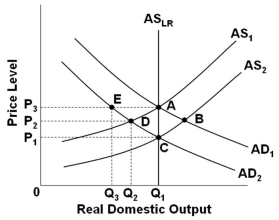Multiple Choice
 Refer to the graph above. Assume that the economy is in initial equilibrium where AD1 intersects AS1. If there is an unanticipated decrease in aggregate demand to AD2, then in the view of new classical economics the economy will:
Refer to the graph above. Assume that the economy is in initial equilibrium where AD1 intersects AS1. If there is an unanticipated decrease in aggregate demand to AD2, then in the view of new classical economics the economy will:
A) Self-correct through a shift in AS, which brings output back to Q1
B) Self-correct through a shift in AD, which brings output back to Q1
C) Need the government to implement expansionary policy in order to bring output back to Q1
D) Need the government to implement contractionary policy in order to bring output back to Q1
Correct Answer:

Verified
Correct Answer:
Verified
Q33: Rational expectations theory considers the aggregate:<br>A) Demand
Q35: <img src="https://d2lvgg3v3hfg70.cloudfront.net/TB4895/.jpg" alt=" Refer to the
Q40: Mainstream economists contend that monetary policy tends
Q40: One reason why the lowest wage rate
Q42: According to rational expectations theory, discretionary monetary
Q96: Monetarists recommend that the supply of money
Q101: Mainstream economists have adopted some ideas from
Q140: If M is $1,000, P is $8,
Q153: In rational expectations theory, a fully anticipated
Q245: In real-business-cycle theory, real output can change